The Savage 110 Scout was designed to be fast and light. Built on one of the most popular actions ever produced, the Scout uses a forward mounted Picatinny rail to help you see and hit faster. This rifle is set up to be your next backcountry survival, zombie apocalypse, and brush hunting platform.
Loaded with performance features, the Scout has an AccuFit modular synthetic stock, forward-mounted rail, and adjustable iron sights to make it a very adaptable platform with the fit and function of a custom rifle straight out of the box.
Function is not ignored, a 16 ½-inch button-rifled compact carbon steel barrel with an aggressive muzzle brake and AICS-style 10 round detachable box magazine make it fast and accurate.
The Story of Savage’s 110 Scout
The Savage Model 110 is a time-proven bolt-action rifle developed by Savage Arms to give the hunters an affordable quality rifle. The model number is derived from its initial retail price of $109.95.
Designed in 1958 by Nicholas L. Brewer, the Model 110 has been in continuous production since that time, making it the oldest continuously manufactured bolt-action rifle in America.
What is a Scout Rifle?
In his book The Art of the Rifle, gun legend Jeff Cooper wrote about a concept gun he called the Scout Rifle. The scout was to be a 39″ rifle with a 19″ barrel weighing seven pounds (including sling and optics).
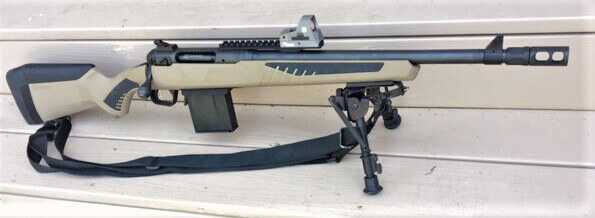
The big idea of the Scout rifle is that by placing the scope forward on the barrel of a lightweight rifle you improve situational awareness for faster target acquisition and quick follow-up shots.
Cooper’s scout rifle was conceived as a field rifle capable of 2 MOA accuracy or better. The size, weight, and functional sling were designated to make the scout easy to carry with practical accuracy.
This weight drove the rifle to be a bolt action. It was to feed from stripper clips or a detachable box magazine. An appreciation for shorter barreled rifles may be Cooper’s most enduring legacy. While short barrels are common today, when conceived in the 1960s this was an unconventional configuration.
This general-purpose rifle was expected to have enough energy to hunt large and small game and defend against animal or feral human attacks while remaining light enough to carry while working in the wilderness for extended periods.
Cooper preferred a heavier round, but I asked Savage for the 110 Scout chambered in .223. Today’s bullet technology makes the .223 highly versatile. It is light, easy to shoot, and has proven effective on small and medium game.
Cooper favored a low-power forward mounted optic with ghost ring backup sights. A scope mounted forward of the action allowed the use of stripper clips and quick single-round loading. It also promotes shooting with both eyes open to improve situational awareness.
Jeff Cooper might have said that the Savage Arms 110 Scout is not a true scout rifle. It is a little too heavy and he would have hated my optic choices. This rifle is a modern incarnation of the scout spirit, a simple and affordable general-purpose rifle.
Red dot reflex sights, which weren’t widely available when Cooper came up with these criteria, are arguably faster than a scout scope and have better low light performance.
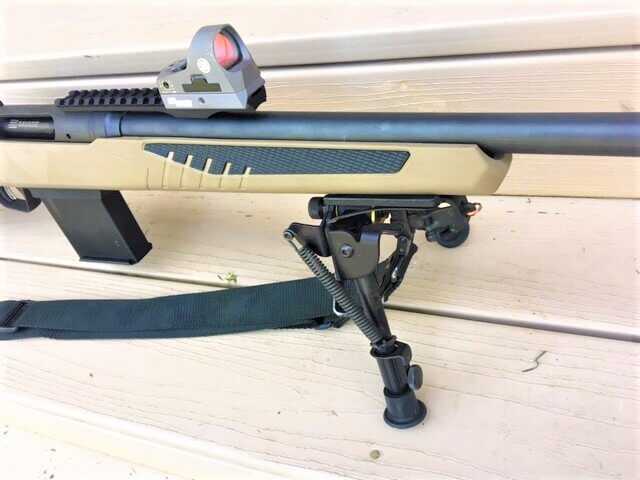
I found the Romeo3 reflex sight is the ideal sighting solution for the scout. The red-notch coating ensures a brilliant red-dot perfect snap shooting. The 3 MOA Red Dot sight has elevation/windage adjustments of 100 MOA.
To extend battery life, Romeo3 is activated through motion-sensing technology, to immediately power up when it senses movement and powers down when it does.
Another option if magnification is needed, a modern conventionally mounted low-power scope has most of the same advantages of the Scout setup with fewer downsides. Since today’s variable powered scopes are far better than those available in the past, we shouldn’t limit a general-purpose rifle to fixed power scopes, either.
I think if Cooper could have seen a modern 1-6x scope with an illuminated reticle in 1980, he would have appreciated the advantages it offers over what we now call the scout scope.
Optika6 1-6×24 Red Dot FFP
To bring out the full capabilities of the Scout, I decided to try a Meopta 1-6×24 Optika6 scope with a Warne mount. The Optika6 is optimized for fast-paced medium-range competition and hunting. This is a great set up for the .223 cartridge providing quick hits from zero to 300 yards and beyond.
The 1X provides a no magnification setting perfect for the red dot and fast reflexive shooting. 6x allows you to see detail on more distant targets to identify threats or prey.
Meopta has been producing high-end European optics in the Czech Republic for over 85 years. The Optika 6 is priced for entry-level shooters seeking better performance than the Amazon optics of questionable origin. They have many options allowing you to get the features you want.
I went with a first focal plane, illuminated red dot, MOA adjustment, K Dot German-style reticle. A red dot lets me shoot fast up close and magnification lets me evaluate at longer range. Let’s unpack this a little bit.
The RD Illuminated Reticle System features a highly defined red dot at the center of the reticle. The illumination control has six reticle intensity settings that accommodate conditions from extreme low-light to bright daylight conditions. Intermediate off positions between every setting allows the user to find their preferred illumination setting quickly.

Magnification is adjusted by rotating the sleeve or with the optional quick-zoom lever, included with the scope. Parallax focus adjustment is on the left side, adjacent to and along the same axis as the illumination knob. Parallax adjusts from 10 yards to infinity.
The proprietary ion-assisted anti-reflective and scratch-resistant lens coatings on the Optika6 are the best in the industry. These coatings eliminate glare and reflections while delivering incredibly bright images. The coatings also protect the lens from abrasion on external surfaces.
Iron Sights
The Scout Rifle is a rugged rifle designed for field use. There’s an aggressive muzzle brake on a threaded barrel which will also accept flash hiders and suppressors.
I’m a big fan of iron sights. You never know when mud or harsh conditions will affect optics. I like options. When you pull off the scope on the Scout you still have an adjustable ghost-ring sight. There is a solid front blade with protective ears.
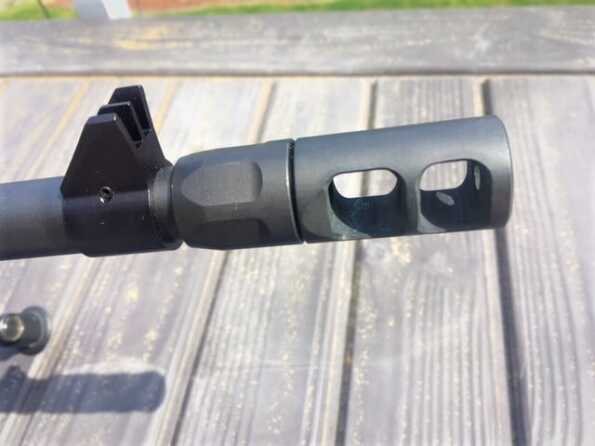
The rear peep sight is adjustable for elevation and windage. I zeroed the iron sights at 50 for a 50/200 yard zero. Even with the wide front sight, accuracy was acceptable, offhand I could hold a 3″ group at 50 yards with ease. The wide sight and the ghost ring work well in a wide variety of lighting conditions.

About the 110 Scout
The Model 110 was designed to be economical from the start. Many of its small parts are made from investment castings and steel stampings. The action and barrel are made from forged steel bar stock.
A small but important feature, the bolt head of the Model 110 floats. A flat spring behind the bolt head gives the assembly a small amount of free movement lateral to the bore axis. This motion allows the locking lugs full contact with the receiver so headspace is held to a minimum every time the bolt is locked.
The barrel is threaded into the receiver and fixed via a large locknut located just ahead of the receiver, with a recoil lug sandwiched between the two. This system lets you change barrels or adjust headspace easily.
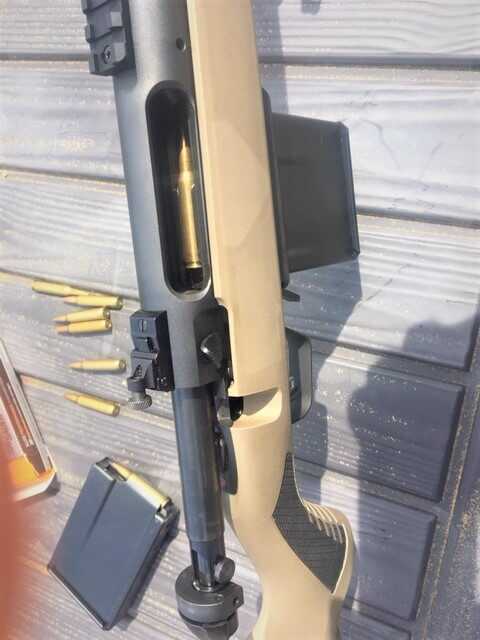
The bolt head is a replaceable part. This means that if you want to re-barrel the rifle for a different cartridge, the bolt head can be changed to a new case head diameter. This allows for simple interchangeability with a wide range of cartridges.
Each bolt head type includes a different means of cartridge ejection. The push-feed bolt heads utilize a plunger-type ejector mounted in the bolt face. The controlled-round-feed bolt heads have a relief cut for a receiver-mounted, spring-loaded folding ejector to pass through as the bolt is retracted.
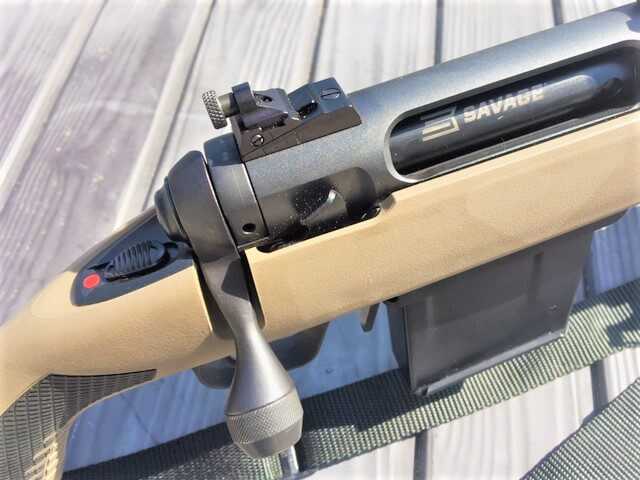
The Scout’s safety is a slider atop the receiver that is easily operated with the thumb of either hand from a shooting position.
I am a fan of magazines for bolt action rifles. It is much easier to load and unload than an internal box. A polymer base plate adapts the 110 Action to feed from AICS detachable magazines.
The rifle ships with a 10-round magazine, but there is a five-round version for hunting. Ten rounds is a common capacity for Scout Rifles. For self-defense, the larger capacity magazine is useful without sticking out too far. Single rounds can be loaded through the ejection port if the magazine is removed.
The magazine release is a well-designed paddle located between the magazine and the trigger guard. It can be easily manipulated with either hand while grasping the magazine.
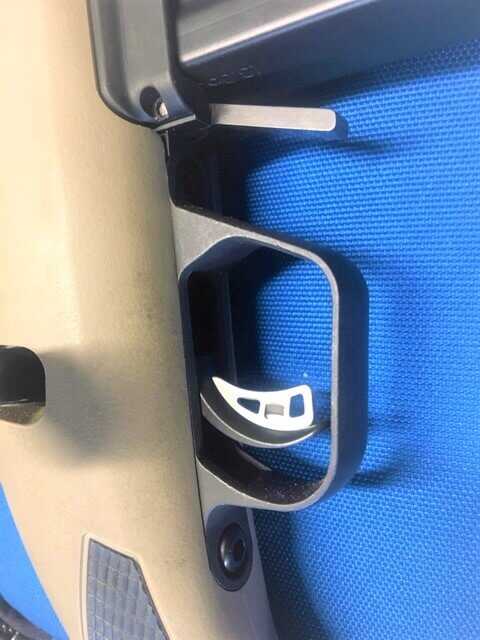
A 6.63-inch Picatinny rail provides 16-slots for mounting a scope or red-dot sight. It is attached to the receiver by two screws and to the barrel by one screw.
Available Calibers:
308 WIN
223 REM
338 FEDERAL
450 BUSHMASTER
AccuFit
AccuFit system provides an array of spacers and risers to quickly adjust comb height and length-of-pull. This provides a custom fit at retail prices. The 110’s five interchangeable risers allow comb height to be tweaked to suit the user’s needs.
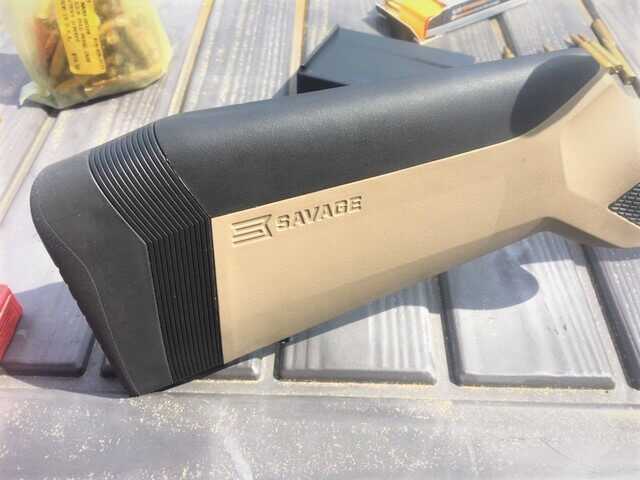
Scout Rifles require the comb height to be just right to get a proper cheek weld for fast and accurate off-hand shooting. I tried the different inserts until I found what felt best.

There are spacers to adjust length of pull, but the 110’s length of pull fit me out of the box. Shooting a rifle with the wrong length-of-pull is a miserable experience.
The ample recoil pad combined with the substantial muzzle brake means felt recoil compares favorably with rimfire rifles.
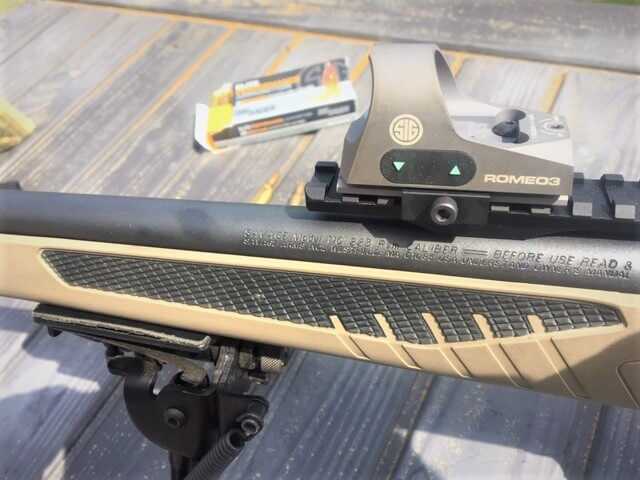
AccuStock
AccuStock engages the action in three dimensions, along its entire length and features an integral, rigid-rail system embedded in the stock and fore-end. This rigid aluminum rail system is embedded in the stock throughout the fore-end for high accuracy potential.
AccuTrigger
The adjustable AccuTrigger provides the flexibility to set the trigger pull to your specific individual preference. Easily adjustable by the shooter, it offers a light, clean pull with no creep, and prevents the firearm from discharging if jarred or dropped.
Savage Arms 110 Scout Quick Specifications & Features:
Bolt Action Rifle
Magpul AICS-style 10 Round Detachable Box Magazine
16.5″ Carbon Steel Barrel with 1:9 Twist
Overall Length 37.5″ to 38.5″ Depending on AccuFit System adjustment
Weight without Optics: 7.72 lbs
Muzzle Brake
Adjustable Iron Sights
Forward Mounted Picatinny Rail
Adjustable AccuTrigger
AccuStock with Soft Grip Surfaces and Recoil Pad
AccuFit System LOP Inserts and Changeable Comb Risers
Sling Swivel Studs
How did it Shoot?
One of the best features of the 110 Scout is the trigger pull. The adjustable AccuTrigger gives the feel and accuracy of an expensive two-stage trigger. This goes a long way towards fast and accurate shooting.
The stiff AccuFit synthetic stock allows the barrel to free float. This maintains barrel harmonics and keeps sling and bipod pressure from shifting zero. That’s a huge boon for accuracy of the firearm usually reserved for high dollar systems. The effort pays off.
The padded grip areas, comb and recoil pad put everything in the correct position and give a nice feel to the gun. The custom-fit provided a tactile connection to the rifle I have not often experienced.

Shooting off of a bipod, I was easily able to hold 2 MOA out to 200 yards. I am sure the accuracy potential of this scope and gun is much higher, but those were my results.

A handy scout rifle shoots off hand fast and accurately. Shooting with irons, red dot sights, and the Meopta 1X6 scope, I shot steel targets and paper, from 25 to 200 yards, using a variety of shooting positions.
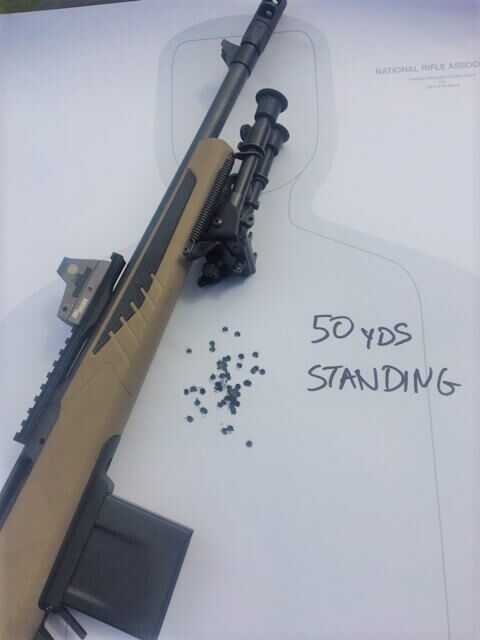
I shot over 500 rounds (mostly pre-pandemic) of assorted loads. With a 16-inch barrel, .223 should maintain lethal velocities for hunting beyond 300 yards. My best groups were from SIG, but Norma shot similar sized groups. PMC performed well also.
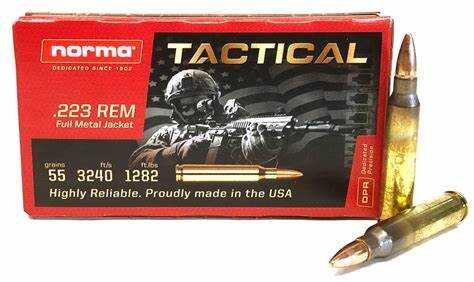
The Scout is a joy to shoot with lightweight and low recoil. The box magazine was fast and the was action smooth.
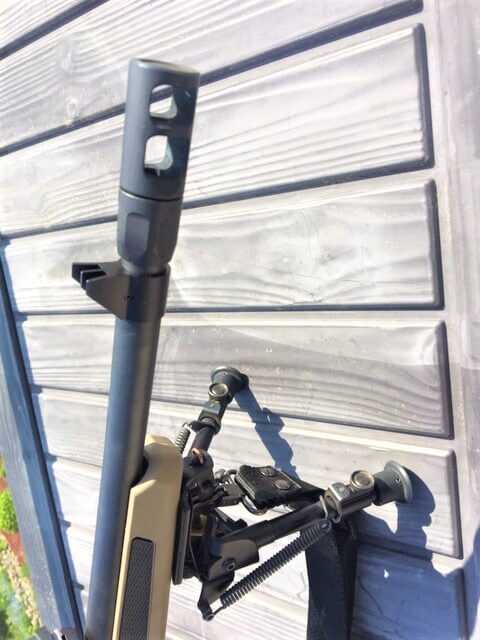
MSRP: $819
I like the Savage 110 Scout. The imbedded rubber gripping surfaces and AccuFit features made for a perfect fit. The trigger is good and the cost is affordable. It’s a good shooting handy rifle with nice look.
I think it would make an excellent choice for rugged use in an austere environment for the shooter on a budget. Simple optics can add capability as needed.


Good afternoon! What is the length of the savage 110 scout if you remove the muzzle brake? Thanks for the answer!
I have the previous model of the Savage 110 Scout Rifle in .308. It is a great gun. My biggest complaint was the cost of magazines at that time.
The rifle was about $350, but the magazines were about $150! I’m not kidding. The cost of 2 magazines would have been almost equal to the rifle itself.
Fortunately, after about 3 years, the price came down to $50.
I will say that it is a great handling rifle and that it does much better than expected.
I’ve actually shot steel targets at 1000 yards with the Scout. The rifle can do what you need it to do as long as you do your part.
As far as zeroing the iron sights, if it’s still shooting high at full adjustment it might be possible to remove the rear sight and sand or “plane” the bottom so that its overall height is lower and the aperture would sit lower when reinstalled. It looks as thought there’s at least 2mm of working material at the base. There may also be some meat to sand away at the base of the aperture’s sliding “perch”. A possible third adjustment would be to open the perch’s channel at the back, as well as sand down the back of the perch, to allow it to slide down little further and lower the aperture. As the rear sight at the furthest end of the trajectory “triangle”, any adjustment at that point will have the greatest effect on the elevation of the POI.
A pain, to be sure, for a new rifle that shouldn’t have this issue, but it may be enough to fix it.
The iron sight’s inability to zero is an issue that Savage has not addressed during manufacture.
I know for a fact they have been aware of this fault for some time.
It could easily be remedied before the rifles are sent to dealers for sale to the public.
Other reviews have mentioned this quirk many times in the past.
I personally contacted Savage to inquire about the irons.
Their fix is always “Sent it back to us for repair”…
I love my other Savage rifles. They are solid, reliable, ergonomically correct and extremely accurate…it pains me to no end this company just lets the 110 Scout to be distributed in this condition. Iron sights are a vital part of the scout platform. Seems counterproductive.
Darrell L Wilson
ETC(SS)USN Ret
Mr. Miller, I appreciate your review of the Savage Scout, and especially the fact that you took “ownership” of the Scout Rifle “concept” based on your needs and experience.
I just happened to get into recreational shooting when Col. Cooper’s Scout Rifle concept was really getting some attention in the gun mags. This was in the early 90s when my Gov., the rabidly anti-2nd amendment Jim Florio had just passed his ‘Assault Weapon Ban’. Overnight my plans on purchasing a “black rifle” were cancelled. I then began the search for an alternative began, and I stumbled upon the Scout Rifle concept. I remember reading everything I could on bolt actions and lever actions, which were being promoted as alternatives to the civilian AR15 platform. But as things typically go for a young father with three kids in a shaky economy, any thoughts of a new rifle had to be shelved, at least for a time.
Fast forward to 2020 (and my point lol), and I found myself rethinking the validity of a Scout Rifle for my needs (especially in our current culture). As I revisited Col. Coopers requirements and his thinking behind them, I realized that what worked for him-in the environments and situations he found himself in (Africa? I haven’t even been out of the states lol), was actually not a good fit for me in my world. My “world” being the Southern end of NJ, where rifle hunting is extremely limited (i.e. shotgun\muzzle-loader\bow for whitetails, .22 lr for trappers and coon hunting, center fire under .25 caliber for coyote\fox, shotgun slug\muzzle-loader\bow for black bear, etc.).
Nonetheless, a short, light, rifle (not sure why we just don’t call them carbines anymore?), with a low power optic still makes a lot of sense. Especially if the big, bad, black-rifles, are ever banned again.
For me, the answer comes in the CZ 527 in either .223 or 7.62×39. It weighs in at 5.94 pounds, only 37.4″, has a great two-stage trigger and iron sights. It comes with swivel mounts preinstalled, uses 5 round magazines (not a deal-breaker for me) and shoulders easy. I am in the process of nailing down my optic, but even with the somewhat oddball 16mm scope bases there are some great options.( It also doesn’t hurt that the rifle sells for under $700).
For *me* the CZ 527 Carbine gets the heart, and most important part of the Scout Rifle concept right. Short, light, iron sights, very good scope options, magazine fed. But-in a caliber (.223) that makes much more sense in *my* environment. As far as real-world applications, my largest four footed threat is a Black Bear and my nearest neighbor’s back porch is literally 12 ft. off the back of my house. The trees are thick as…well…a North East forest, and my longest shot would more realistically be 35-50 yards than 300 yards. (Even at 200 yards I am well within the effective range of either the .223 or the 7.62×39).
I, like anyone with half a brain, has the utmost respect (and even awe) for Col. Cooper. Not sure “legend” even gets close to what this man represents to the shooting community. But, I, like you, think that while the good Col. may not completely agree with our personal “Scout” choices, he would understand the thought process behind them-and respect them.
Sincerely,
Anthony G.
I again would challenge you to review and test other FFP scopes available in 6 x 24 x 50, 4 x 14 x 44, 1 x 8 x 24 with 34 mm tube, 1 x 4 x 24 and 1 x 6 x 24 in SFP!!! It’s becoming extremely transparent that y’all only review companies that advertise with you, which makes your reviews skeptical at best!!!
I can assure you that the editors at GunsAmerica do not require good reviews for advertisers. I select items to review based on their availability, if I like something and I can get one, I write about it. If I don’t like it, I don’t write about it. I want to share products with you that I like and that can perform.
I like this rifle although it’s not needed. I’ll pick one up to play with this winter. To address brother Douglas’s question- Col Cooper did mention a semi auto is an option but it didnt make wieight.I know a guy that made a scout mini 14. Col Cooper had a very narrow criteria for a Scout Rifle.Anyone is free to call something whatever they want but since he invented the concept he gets to define it.Why a bolt action? Well if your a handloader you dont have to chase your brass all over. Also you can use ammo that may not function in a autoloader- like reduced loads.Interesting that Cooper had Scout rifles not only in 7.62 but also 350 Remington Magnum which he took to Africa. He proved his concept was sound.
What is the maximum length of pull ? I’m 6′ 5″ and have that problem a lot. That’s 1 reason I have an AR10
The stock spacers increase length of pull from 13 to 14 inches in ¼-inch increments, and the five comb risers offer 5/8 of an inch in comb height variation in 1/8-inch increments.
nice
Ok… Right up front – I’m not 1/10th as smart about rifles as most of you ‘gun nerds’… But I have killed a few people with an AR, so there is that…
One thing that has always bothered me about the ‘Scout Rifle’ concept, it that they’re always bolt action…
I see in this article, that it was the weight that forced the bolt-action decision, but is that still the case ?
I also see that the optic ( added weight, no ? ) is mounted forward for ‘situational awareness’ ( I would agree there ) and ‘quick follow-up’…
Well, there’s nothing better than a semi, or even a binary trigger, for a ‘quick follow up’…
Like the college kids like to say… ” Convince me I’m wrong ! “
Yeah, semi’s are nice…but they can be ammunition sensitive and can jam all too easily, making them into not-very-useful clubs. This goes double for Stoner’s stuff…I carried an M-16 in ‘Nam and it damn near got me killed a few times by ripping the head off a fired case and then spitting said head into the rifle’s works, meaning I had to field strip and clear my weapon under hostile fire.
Bolt actions don’t do this. They may not be as fast as a semi- but they aren’t as prone to jamming at inopportune times, either.
As for a follow-up shot, I’ve never had a problem making one. Needing to follow up is generally rare, though.
The only semi I have is an old M-1 (Winchester built). It’s ancient but still shoots better than I can. And it never jams – ever.
Can’t say that about any AR- though…
Enjoy your ’10. I’ll stick to bolt action, though (and maybe wind up buying one of these 110’s). I do note that the Savage 110 is like an old aircooled Volkswagen: you’ll spend more on after-market stuff than you will on the thing itself, dammit. Still, it looks awfully nice…
The original M16 was plagued by bad ammo also.
Fast forward a few years. I’ve put a few thousand rounds through an M16A1 and A2 and have NEVER had a failure. In fact, I’ve seen just as many failures in bold actions as I have AR style rifles. Specifically a Savage rifle.
A 110 long hunter that had the extractor fail. Literally it fell OFF the bolt. Savage was good enough to send me the extractor, extractor spring and the little bearing that goes with it.
25 rounds later, that same rifle failed me again. Firing pin does not make contact with the primer.
Meanwhile, I’ve now put about 10,000 rounds through various AR platform rifles and the only failure was when using steel cased ammo. Once the barrel heated up, the cases don’t like to be extracted. Change back to brass and no failures.
Bad experiences with the original AR don’t equate to failures now.
A comparison of combat weapons and survival weapons is apples and oranges.
I’m often amused at those that can’t see that.
Yes, many combat weapons will work as survival weapons, but at what cost in other areas?
Great article…
The iron sight’s lack of adjustment range issue is a known problem on the 110 Scout.
Many purchasers ( including yours truly) have attempted to address the issue with Savage only to be told to return the rifle for adjustment.
This could have been remedied long ago but the manufacturer has chosen to skirt the issue rather than fix it.
The iron sight is a vital part of the scout rifle concept and this issue could easily be fixed during production…eliminating the need to return the rifle for something as simple as a slightly higher front blade or a few more clicks on the rear peep.
It’s a fact that most buyers elect to mount optics…but I agree with you!
I like options..and.. the irons are only a decoration if they can’t be zeroed!
Respectfully
Darrell L Wilson
ETC(SS)USN Ret
I was able to get on target with a little hold under. Savage tells me they have addressed the issue with new rifles. When I get my hands on one, I will have a better idea what it looks like.